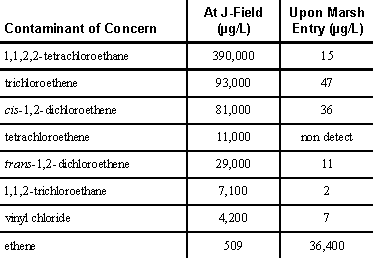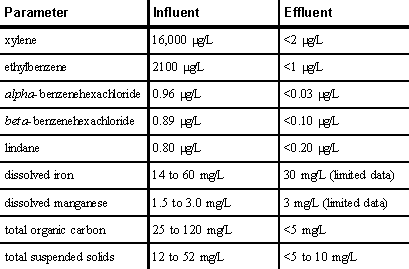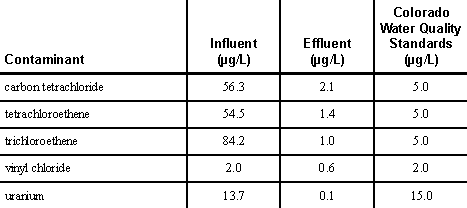|
Ground Water Currents, April 2001, Issue No. 39ContentsCurrent Field Studies on Phytoremediation at Aberdeen Proving Ground Funnel-and-Gate Treatment System for Pesticide-Contaminated Ground Water Iron Reactive Barrier Used at Rocky Flats Site Technology Call for Measurement of MTBE in Ground Water
Current Field Studies on Phytoremediation at Aberdeen Proving Groundby Steven Hirsh, U.S. EPA/Region 3 Phytoremediation is under evaluation as a remedial technology for contaminated ground water at the J-Field Superfund site located on Aberdeen Proving Ground (APG), MD. This five-year study is conducted under a joint partnership among the U.S. Army, U.S. EPA Region 3, and the U.S. EPA Environmental Response Team Center as part of the U.S. Department of Defense (DOD) efforts to use emerging remediation technologies. The success of conventional technologies such as soil washing, soil vapor extraction, and pump and treat systems had been found to be hindered significantly by complex site conditions at J-Field. These difficulties include the presence of unexploded ordnance, a low permeability aquifer, and a persistent contaminant source fed by residual non-aqueous phase liquids. Recent analysis of in situ bioremediation processes enhanced through phytoremediation demonstrates that degradation of chlorinated volatile organic compounds (CVOCs) is occurring actively in the J-Field study area. APG is located along the western shore of the Chesapeake Bay. Over the years, military weapons testing has caused extensive release of chemicals to ground water and soil at J-Field, where disposal activities took place in a 500- by 800-foot area known as the toxic burning pits. Significant levels of CVOCs were detected in the area’s ground water, which flows from below the pits toward an adjacent freshwater marsh. The underlying aquifer is comprised of interbedded, low permeability fine sands and clayey silts that can sustain well yields of only 0.3-1.0 gallons per minute. Low permeability sediments in this area, coupled with relatively low ground-water recharge, produce an average ground-water flow velocity of approximately 10-15 feet per year. Phytoremediation was selected to reduce CVOC mass loading to the marsh by providing hydraulic containment of the CVOC plume and overall CVOC mass reduction. A pilot-scale study of this technology began in 1996 with the planting of 183 hybrid poplar trees in a U-shaped configuration surrounding the burning pits. Earlier agronomic sampling had indicated that the fast-growing, deep-rooting characteristics of hybrid poplar trees would make them suitable for this area’s soil characteristics, climate, and hydrology. Prior to planting, modeling was performed to predict the time required for the poplar trees to achieve aquifer restoration. Modeling estimates took into account contaminant uptake rates as determined by transpiration stream concentration factors, transpiration rates, and average contaminant concentrations in ground water. Analytical modeling also was used to position the poplar trees for maximizing ground-water withdrawal efficiency, taking into account the ground-water flow rate, hydraulic conductivity, hydraulic gradient, aquifer thickness, and potential plume capture width. In 1998, several trees that had died were analyzed and replaced by additional hybrid poplars and two native tree species (tulip trees [Liriodendron tulipiferia] and silver maple [Acer saccharinum]). Different methods were used in this second round of planting to encourage more extensive tree rooting. Ongoing sampling and analysis indicate that successful results are being achieved through phytoremediation in the study area. Generally, by the time ground water is discharged from J-Field to the adjoining marsh, essentially non-detect levels of the primary contaminants (1,1,2,2-tetrachloroethane and trichloroethane) are reached (Table 1). Using very sensitive sampling techniques, volatile emissions from a small number of trees can be measured; however, extensive air monitoring has shown no measurable volatiles in the ambient air.
Other potential impacts of phytoremediation also are under evaluation in the J-Field area. For example, to assess the health and functioning of the soil community in this area, soil samples are taken periodically for nematode identification and enumeration. In addition, regular monitoring is conducted to assess the effects of the poplar trees on the ground water. Pending final study results gained during 2001, it is anticipated that EPA and DOD will implement a full-scale phytoremediation program at APG. For more information, contact Steven Hirsh (EPA/Region 3) at 215-814-3352 or e-mail hirsh.steven@epa.gov. Funnel-and-Gate Treatment System for Pesticide-Contaminated Ground Waterby Annie Godfrey, U.S. EPA/Region 4, Karl Hoenke, Chevron Environmental Management Company, and Dean Williamson, CH2M Hill A full-scale funnel and gate (F&G) system began operating in 1998 at the Marzone Superfund site near Tifton, GA, to treat ground water contaminated with pesticides and other organics. This passive treatment system was selected as an alternative to the pump and treat remedy (specified in the site’s record of decision), which may not be effective at this site. The U.S. EPA/Region 4, Chevron Environmental Management Company, and CH2M Hill have been closely monitoring the F&G system’s performance, and have found that the system is reducing total xylene and pesticide concentrations by more than 99 percent. Contaminants accumulated at the Marzone site as a result of various pesticide formulating activities that took place between 1950 and 1983. These contaminants include DDT, toxaphene, atrazine, dieldrin, chlordane, lindane, alpha-benzenehexachloride (BHC), endosulfan, methyl parathion, xylene, and ethyl benzene. Analytical sampling indicated total xylene concentrations as high as 20,000 µg/L and total BHC concentrations of up to 4 µg/L in ground water. The affected shallow surficial aquifer, which extends to approximately 20-25 feet below ground surface, comprises primarily interbedded silts and clays, with some discontinuous sand lenses. Ground-water flow velocities in this aquifer unit typically range from 10 to 20 feet per year. Bench-scale testing of the capability of various media to remove or degrade hydrocarbons and the applicable pesticide classes indicated that granular activated carbon (GAC) was best suited to serve as the system’s adsorptive medium. Based on factors such as residence time with the GAC, surface loading rates, constructability, life cycle costs, and corrosion resistance, a gate design that uses pre-cast vaults was selected. The F&G system comprises three three-foot-square, 16-foot-deep concrete vessels with interconnecting piping that allow for operation of two vessels in series or in parallel, with both up-flow and down-flow modes. This configuration is intended to accommodate changes in operational modes or reactive media that may be made during potential operation of the system over several decades. The results of ground-water analysis conducted at the time of system start-up demonstrated effective GAC performance (Table 2). Currently, the system is treating approximately 1 to 2 gallons of water per minute. Overall analytical results indicate that total xylene concentrations are reduced from 15,000 to 20,000 µg/L in the influent to less than 1 µg/L in the effluent, and total BHC concentrations are reduced from 1 to 4 µg/L to less than 0.05 µg/L.
Efforts also were made to use innovative methods for construction and operation of the F&G system. For example, to minimize impacts on a nearby transportation corridor and the surrounding community, a vibrated beam method was used to install the cutoff wall (funnel) instead of soil-bentonite slurry walls, which typically introduce major surface disturbance. An additional innovative method (biopolymer slurry) was used to construct the system's collection and discharge trenches. This method eliminated the need for trench boxes to support the side walls and eliminated the need for personnel to enter the trench. Following initial operation of the system, vents were installed to reduce a vapor accumulation that resulted from biodegradation of the guar (biopolymer) used in trench construction. Analysis of influent and effluent ground-water samples indicates that the F&G system is removing all target contaminants of concern to below cleanup standards, and in most cases to below detection limits. Accordingly, the record of decision for this site has been amended to establish this technology as the permanent ground-water remedy. For more information, contact Annie Godfrey (EPA/Region 4) at 404-562-8919 or e-mail godfrey.annie@epa.gov, Karl Hoenke (Chevron Environmental Management Company) at (925) 842-9259 or e-mail khoe@chevron.com, or Dean Williamson (CH2M Hill) at 352-335-7991 or e-mail dwilliam@ch2m.com. Iron Reactive Barrier Used at Rocky Flats Siteby Thomas Holdsworth, U.S. EPA/National Risk Management Research Laboratory The U.S. EPA began working with the U.S. Department of Energy (DOE) in 1995 to characterize a contaminated ground-water plume at DOE’s Rocky Flats site outside Denver, CO. DOE is working to achieve closure of the Rocky Flats site by 2006, and considers remediation of this plume a crucial element of site closure. Based on the results of site characterization and ongoing commitment to utilize innovative treatment technologies, DOE decided to remediate the contaminated ground water through use of a passive barrier. This type of barrier system requires no operational energy and minimal maintenance, which results in a substantial cost savings over use of an alternative pump and treat system. Performance assessment of the barrier through EPA’s Superfund Innovative Technology Evaluation (SITE) Program indicates that the barrier system is removing approximately 99% of the plume’s primary contaminants. Ground-water contamination in this area—known as the mound site plume—originated from a former waste drum storage area used by DOE in the 1950s. Consisting of shallow ground water with a flow rate of 0.5 to 2.0 gallons per minute, the plume horizontally extends approximately 220 feet. Its primary contaminants are uranium and volatile organic compounds (VOCs), including carbon tetrachloride, tetrachloroethene, trichloroethene, and vinyl chloride. Following excavation and removal of the contamination source in 1997, the passive barrier (designed by EnviroMetal Technologies, Inc.) was installed in the summer of 1998. This barrier system begins with the downgrade-side collection of ground water in a subsurface hydraulic barrier (French drain) lined with high-density polyethylene. The drain is located in the unconfined aquifer at depths ranging from 8 to 15 feet below ground surface. Ground water is diverted through the drain to piping that transfers it by gravity to the reactive media treatment system. The system consists of two 10-foot (wide) by 5-foot (deep) cylindrical reactors, each of which contains 337 cubic feet of granular, reactive (zero-valent) iron. To provide a ground-water flow rate of 1 gallon per minute over a duration of 20 hours in each reactor, the reactors were sized accordingly and installed in series below surface grade. By treating ground water sequentially in both reactors, VOCs are dechlorinated to nonchlorinated hydrocarbons, and uranium in the oxidized state (U6+) is converted to uranium in the reduced state (U4+) and precipitated. Following treatment, ground water exits the barrier system directly through surface water that flows to retention ponds. EPA and DOE have monitored the influent and effluent of this barrier system on a quarterly basis since September 1998. Table 3 provides the average results of ground-water sampling conducted through June 2000.
In addition, water samples in 1-foot increments throughout the reactive media have been collected since project start-up to monitor contaminant breakthrough. To date, breakthrough of VOCs and uranium has been confined to the top three feet of the first reactor in the treatment sequence. For more information on this SITE demonstration, contact Thomas Holdsworth (EPA/National Risk Management Research Laboratory) at 513-569-7675 or e-mail holdsworth.thomas@epa.gov, Norma Castaneda (DOE/Rocky Flats Field Office) at 303-966-4226, or John Vogan (EnviroMetal Technologies, Inc.) at 509-824-0423. Technology Call for Measurement of MTBE in Ground WaterThe U.S. EPA’s Environmental Technology Verification (ETV) Site Characterization and Monitoring Center is interested in testing field-portable technologies for measuring methyl tertiary butyl ether (MTBE) in ground water. Criteria for participation in the program include development of a commercially available technology, willingness to share a portion of the testing costs, willingness to participate in the study design process, and a commitment to deploy and operate the technology at one or more contaminated sites during the verification testing process. To participate in this program or refer a technology for verification testing, contact Wayne Einfeld, ETV Project Manager (U.S. Department of Energy/Sandia National Laboratories) at 505-845-8314 or e-mail weinfel@sandia.gov, or Eric Koglin, ETV Program Manager (U.S. EPA/National Exposure Research Laboratory) at 702-798-2432 or e-mail koglin.eric@epa.gov.
|











